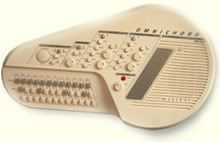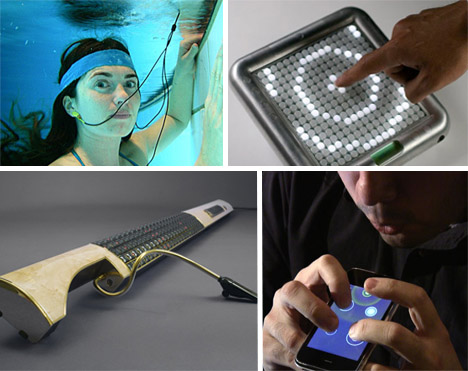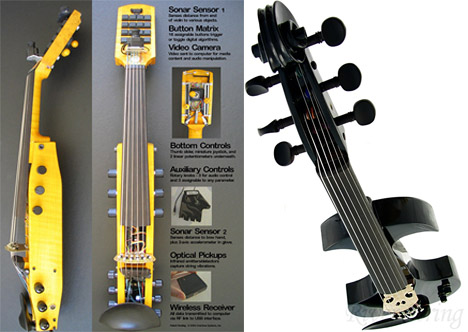
27.2.12
31.5.11
Música hace 35000 años
14.3.11
El coleccionista de sonidos.
1.6.10
27.4.10
Larry Cover i la seva música experimental
26.4.10
INSTRUMENTS CASOLANS
Instrumento musical con rayos de luz.
http://www.youtube.com/watch?v=pe99m4HICR0&feature=player_embedded#!
15.4.10
PANTALOFONO
Mediante micrófonos de contacto e interruptores distribuidos por el pantalón y la suela de los zapatos, los miembros del grupo Mortadelia crean un Pantalófono. Después de grabar samplers con la batería, conectan todos los microfonos a la mesa de mezclas y adjudican a cada uno un sonido determinado. Es sencillo y barato, y partiendo de esto, las posibilidades son infinitas!
12.4.10

Grupo de experimentación ritmica y sonora nacido en el 2006 dentro de la cooperativa social GP2, para la formación de pensonas con discapacidad mental.
Crean instrumentos a partir de material reciclado y contando con los elementos agua y viento.
Los componentes del grupo con discapacidad mental tocan estos instrumentos generando un espectaculo de paisaje sonoro experimental.
6.4.10
Mini retro sintetizadores de papel
4.4.10
22.3.10
Omnichord
Vídeo Omnichord:
9.3.10
Escultura Sonora Cinética
- Que estén hechos de partes fáciles de conseguir y ensamblar con un mínimo de herramientas.
- Que puedan armarse de distintas maneras para experimentar con los sonidos y combinaciones de sonidos.
- Que estén hechas de forma modular para que puedan hacerse cosas más grandes juntando varias partes.
- Que los diseños no produzcan sonidos monótonos e insistentes sino de preferencia de forma impredecible y cambiante.
Vídeo de la obra "N Cycle" de David Marín Romaen funcionamiento:
Marín se inspira para darle forma en las moléculas, es decir, la forma que adopta es la de unidades repetidas montadas sobre una estructura base, como nuestro ADN y el resultado de su obra no es el sonido de una cajita de música, sino que evoca una cascada, la lluvia o el paso del viento por unos sonajeros.
Joaquín Orellana (del cual se se inspira David Marin), es un hombre que nació en la ciudad de Guatemala en 1937, desde temprana edad mostró interés por los sonidos y la música que le llevaron a graduarse de violinista en el Conservatorio Nacional de Música. Luego estudió en el Instituto Torcuato Di Tella en Buenos Aires.
Los útiles sonoros que fabrica son máquinas diseñadas para reproducir ciertos pasajes musicales, o para ser parte de un paisaje sonoro sobre el cual contrastan otros instrumentos más melódicos.
Vídeo que muchos de sus Utiles Sonoros:
6.3.10
CRAKLEBOX/caja de ruido
Lo mejor de este aparato es que es relativamente facil y barato de hacer en casa si tienes conociminetos basicos de electronica
un virtuoso
gusanos noise
En estas paginas hay esquematicos para hacerse una craklebox en casa
http://noisybox.net/electronics/cracklebox/
http://www.eam.se/kraakdoos/
2.3.10
Miya Masaoko
Miya masaoka es una compositora y artista japonesa, que crea interesantes obras mezclando musica y conceptos científicos.
En algunas de sus creaciones usa la interaccion con plantas para crear composiciones musicales y reflexionar sobre nuestra relación con estos seres vivos y sobre la naturaleza de la existencia consciente en otros organismos vivos.
En estas "piezas" musicales las plantas tienen electrodos colocados en las hojas y con estos se miden la respuesta fisiologica de la planta a la interacción de los participantes , se monitoriza y se convierte en sonido a traves de MIDI y sintetizador,
Brainwaves and plants
Pieces for plants
Laser Koto
Es un instrumento que ha creado inspirandose en el Koto, un instrumento de cuerda japonés, pero utilizando laser.Podemos tocarlo a traves del haz de laser de manera parecida a como se toca un koto pero al percutir la "cuerda laser " se disparan diversos sonidos , algunos tipicos del koto y otros añadidos por ella ,por ejemplo sonido de cristales rotos.
Otro de sus proyectos que me ha llamado la atencion es thinking sounds , muy en la linea del anterior de las plantas.
Este proyecto es una composición interactiva ,para 8 musicos , computadoras , ondas cerebrales de un miembro de la audiencia y ondas cerebrales pregrabadas.Estas ondas cerebrales son usadas de varias maneras en la composición
1 el miembro de la audiencia lleva un casco cerebral EEG con el que se hace audible la salida de voltaje del cerebro , esta se oye en tiempo real sin procesar y tambien procesada mediante ordenador.
2Las ondas cerbrales pre--grabadas se usa su representacion grafica superponiendolas aun pentagrama para crear una notacion escrita de su expresion musical que es luego interpretada junto con los gestos expresivos que esas ondas cerebrales implican
3la actividad cerebral se interpreta traves de MIDI y se mapea para sintetizador en el cual las ondas se expresan en tono, tiempo, y relacion de timbre .Los musicos entonces improvisan a traves de la salida MIDI.
4.En la parte final los musicos orquestran una interpretación de los datos diferenciados de la ondas beta , tetha, alpha y de los movimientos oculares
No he encontrado video de esta pieza ,es una pena porque es la que más me interesaba
28.2.10
THEREMÍN SOLAR CASERO
Se necesita: una caja de Altoids y una placa solar.
Instrucciones: http://blog.makezine.com/archive/2008/07/build_solar_theremin.html
22.2.10
Deixalla tecnològica - Instruments musicals
os recuerdo algunos enlaces de lo visto en la segunda mitad de esta mañana.
Por un lado, Telenoika, que además de realizar talleres, desarrollar herramientas y proyectos varios, ofrecer y recopilar convocatorias y demás estoy seguro que estarían encantados de ofrecer soporte o colaborar de algún modo con proyectos que les interesen.
Entre otras cosas, del 22 al 31 de marzo realizarán un Taller de Reencarnació de Hardware, donde se construirán theremins, oscilocopios, y demás instrumentos audiovisuales.
Este taller lo realiza la Orquestra dels Luthiers Drapaires, una de las vertientes de Telenoika que probablemente más afinidad tenga con la asignatura.
Aquí un pequeño vídeo de su participación en el SonarMàtica pasado y una recuperación de un post publicado por una alumna hace ya casi un año:
Sónar 2009: L'Orquestra dels Luthiers Drapaires from mediateletipos on Vimeo.
14.12.09
The Future Sounds Like This: 10 Magnificently Modern Musical Instruments
The Future Sounds Like This: 10 Magnificently Modern Musical Instruments
The study of musical instruments (’organology’ – no, really) is the study of the human condition. Every culture is defined by its own distinctive set of trills, whistles, parps, honks and beats, and every corner of the world has evolved its own location-specific indigenous instrument to renew a sense of cultural identity through noisy self-expression. And instruments evolve – never more so than now, in the midst of a technological revolution that has opened up entirely new ways to make music. So settle back and compose yourself as we look at ten new instruments that look set to accompany us into the world of tomorrow.
1. Eigenharp

In development for 8 years with funding of over £10m / $16.5m, the Eigenharp is a slow-crafted technological marvel. 120 keys (each one tilting to give a flexible tone), percussion buttons, built-in sound management capabilities including recording, playback and looping, and a potentially limitless range of noises thanks to running on uploaded digitally sampled sounds. It is played via keyboard, tap-pad and mouthpiece – and the result is an instrument that sounds like a band.
http://www.youtube.com/watch?v=zcVqJh0qEMc&feature=player_embedded
2. Electric Violin
Similarly digitally enhanced are the electric violins, a family of new hybrid instruments that are sufficiently well-established to become a mainstay of the modern music scene. Thanks to electrical pickups inside or outside the instrument’s body, the violin’s vibrations are run through electronic processing and transformed into any sound under the sun – most effectively, the noise of an electric guitar. Witness the magic of Ed Alleyne-Johnson performing on the streets of Chester, England.
http://www.youtube.com/watch?v=vUO6kYLb6As&feature=player_embedded
3. Tenori-On
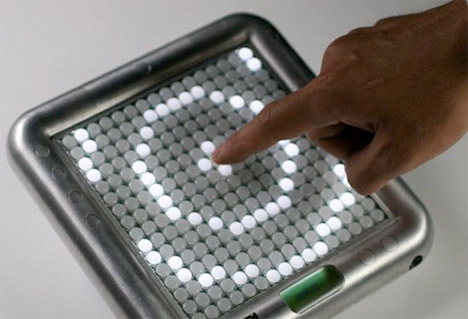
No, this isn’t the first good-to-go version of Minesweeper: this baby is for making beautiful music with. The 16 x 16 grid of LED lights on the Tenori-On responds to touch and to real-time looped programming, creating soaring, rippling compositions that mesmerise beginners and experts alike (Peter Gabriel is a fan). If you want a hands-on demonstration of its power, try Andre Michelle’s ToneMatrix, an online AudioTool-powered simulation.
http://www.youtube.com/watch?v=_SGwDhKTrwU&feature=player_embedded
4. Samchillian

Musical instrument or chest expander? You’d be forgiven for asking – but the Samchillian is a new, ergonomic-minded take on the keyed instrument, with each key representing a relative, not fixed, note. As the musician plays, the function of each part of the instrument is constantly changing, allowing a full range of musical expression (provided the player has a really good memory, of course).
5. BeatBearing
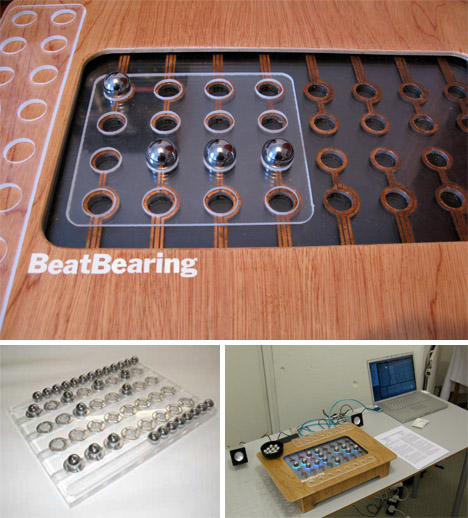
And moving further into the realm of instruments that look like anything but – we have the BeatBearing. Instead of generating noise itself, the BB triggers the timing of preselected types of percussion – simply drop a steel ball-bearing in the right slot to get the beat you want, when you want. The inventor isn’t interested in manufacturing his design: instead, he has published the plans on DIY-tech online magazine MakeZine to encourage people to build their own - and with more than 1 million views of the Youtube demo (below) at the start of this year, we reckon there will be plenty of takers.
http://www.youtube.com/watch?v=wreP8FMupyM&feature=player_embedded
6. Hapi Drum
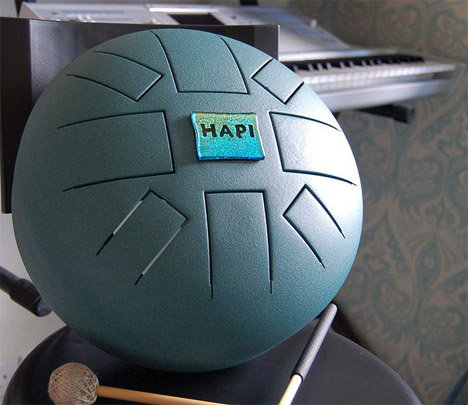
At least the Hapi looks like what it is (well, kinda) – a steel drum with a hole in the base that allows the player to control the amount of noise emerging, using their lap. Since each key (or “tongue”) is part of the main body of the instrument, each note is accompanied by a subtle resonant harmony from other musically compatible notes. Time for a demonstration, methinks…
http://www.youtube.com/watch?v=PW-GZ05htLE&feature=player_embedded
7. Electroencephalophone

At first sight, you’re looking at a lady trying to listen to her iPod underwater, and a collection of buff young people stood up in a hot-tub. In fact in both pictures depict music-making, via an electroencephalophone – a device that converts brainwaves into sound (and therefore a quintephone). The lady is psychotherapist Ariel Garten participating in a concert performance – and the “hot-tub” trio are an electroencephalophonist and two assistants accompanying on electrocardiophones.
8. Hydraulophone
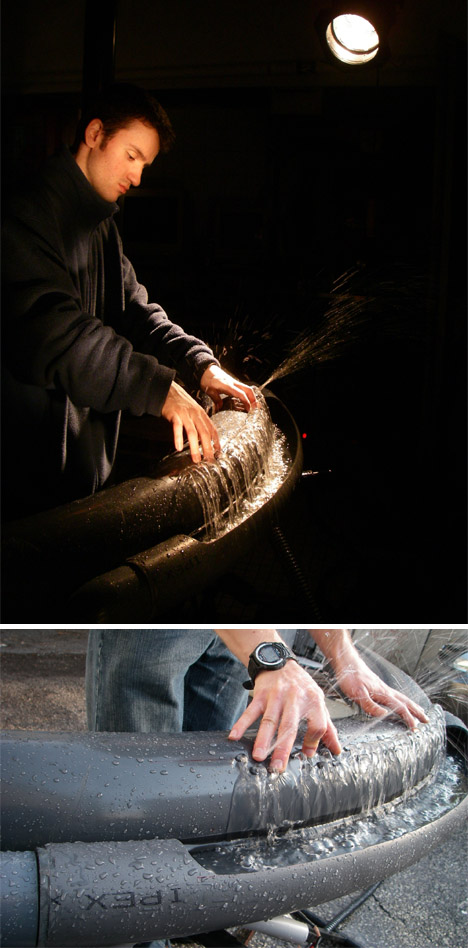
Now to the merry, messy world of the hydraulophones. Water flows out holes in the instrument, and the player uses his fingers to block or divert each stream, triggering internal mechanisms – discs, shafts or valves – that produce sound. In other words, it works like a woodwind instrument, except the wind is replaced by water (which doesn’t directly create the sound).
http://www.youtube.com/watch?v=tnJb9WyhCUc&feature=player_embedded#
9. Drawdio
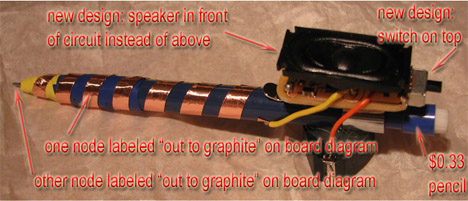
Daring you to not burst out laughing when it gets underway is the Drawdio, a homespun theramin. There are a number of ways to make one (cheaply and easily), but the working principle remains the same in all models – it runs a current through the graphite deposited from the end of your pencil (or any other appropriate medium, including yourself), and translates it through a synthesizer to create a noise like a kazoo in a gale.
http://www.youtube.com/watch?v=PV_w38ldZaE&feature=player_embedded
10. Ocarina
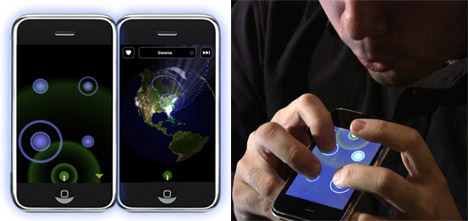
But for breadth of lateral thinking, hats off to Smule, the inventors of the Ocarina iPhone application. Using the phone’s built-in movement sensors and touch screen, your phone becomes either a wholly keyed instrument…or a kind of flute, by detecting the passage of your blown breath and translating it into intensity of sound. Once you’ve finished your piece, upload it to the Ocarina online community and listen to the work of others. A virtual instrument that automatically shares its output online – can you get more contemporary than that?
http://www.youtube.com/watch?v=RhCJq7EAJJA&feature=player_embedded
Magical Music: 5 of the World’s Weirdest Instruments
Magical Music: 5 of the World’s Weirdest Instruments

Most music lovers can agree that music doesn’t always follow the rules. Some of the most beautiful melodies have come from artists who chose to do their own thing despite conventional wisdom. The same is true for artists who create new instruments. Where would modern music be without the “crazy” instruments and techniques invented and modified over the years? These instruments are among the most innovative, the most creative, and the most bizarre out there.
Uberorgan
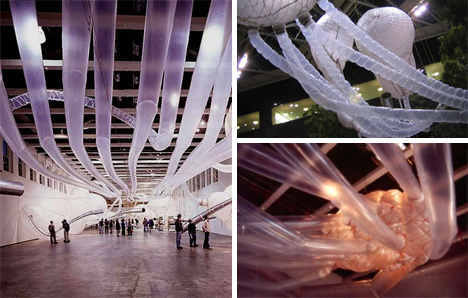
When Los Angeles artist Tim Hawkinson toured around the country with a massive indoor sculpture, he caused big reactions from just about everyone who saw it. Many of them wondered just what it was, and they can be forgiven for not understanding immediately. After all, the 300-foot long sculpture was comprised largely of 13 bus-sized inflated bags and was simultaneously organic and alien. But when it started playing, it was obvious: the Uberorgan was a massive musical instrument. The entire assembly looked like massive ethereal jellyfish suspended in mid-air, but operated like the giant lovechild of a bagpipe and a pipe organ. A visual sensor “read” notes from a scrolling 200-foot-long roll of Mylar to entertain viewers with a score he composed just for the Uberorgan.
http://www.youtube.com/watch?v=POCdAZdDWuw&feature=player_embedded
he Great Stalacpipe Organ
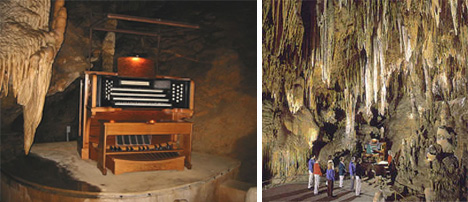
The world’s largest instrument resides in a cave in Virginia, and the music it produces is both earthy and otherworldly. The Great Stalacpipe Organ was created in 1954 after Pentagon scientist Leland W. Sprinkle noticed that the stalactites in Luray Caverns produced resonating notes upon being struck. He spent three years tuning stalactites to precise pitches – with sandpaper. He then wired rubber mallets to strike the stalactites when corresponding keys are depressed on the organ’s keyboard. The organ still plays today for visitors to Luray Caverns.
http://www.youtube.com/watch?v=7ys5fdrsAUM&feature=player_embeddedThe Nano Guitar
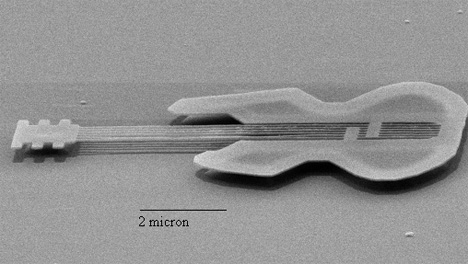
If you thought playing a ukulele was hard, try plucking this tiny guitar. It’s a six-string guitar made of crystalline silicon, and it’s no bigger than a single cell. Each string is 50 nanometers wide: the width of 100 atoms. Researchers at Cornell University created it in 1997 to showcase emerging technology for manufacturing a new generation of electronics. Though it can technically be played (if you happen to have access to an atomic force microscope), the 10 micrometer-long instrument would only resonate at inaudible frequencies.
Croatia’s Sea Organ

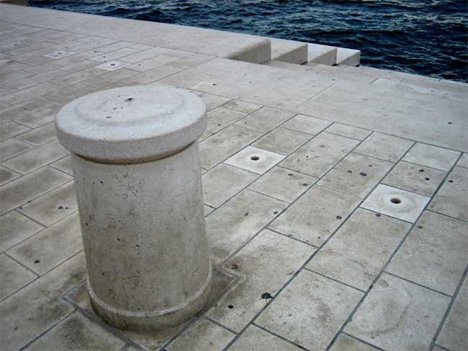
Visitors to the sea front in Zadar, Croatia used to be greeted by grim, ugly concrete walls. But since the public unveiling of the Sea Organ in 2005, visitors have been able to visit the sea front to enjoy the music of nature. The Sea Organ is a musical instrument that consists of 35 musical tubes with openings on the above concrete stairs. Movement of the sea’s waves pushes air through the openings, creating incredible chords and dissonant tunes. Similar instruments exist in San Francisco and Blackpool, but Zadar’s version can be heard more consistently and has done wonders for the tourist trade in the area.
http://www.youtube.com/watch?v=pQ9qX8lcaBQ&feature=player_embedded
The Viennese Vegetable Orchestra
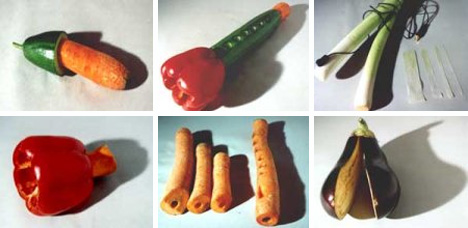
Thought to be the only orchestra in the world using nothing more than vegetable instruments to make music, the Vienna Vegetable Orchestra has been performing around the world since its formation in 1998. Its members carve, cut and tweak fresh produce to create a multisensory musical experience. Their instruments are made fresh right before every performance, and after they wow audiences with their musical prowess their staff cook makes a delicious vegetable soup from some of the vegetables – hopefully not the parts the musicians have been blowing into. Just don’t ask the orchestra members if they’re all vegetarians; they’re tired of hearing that question over and over.
http://www.youtube.com/watch?v=hpfYt7vRHuY&feature=player_embedded
11.12.09
Beatbox
Beatbox+flauta travesera:
Kitchen Beatboxing:





